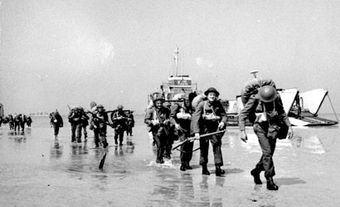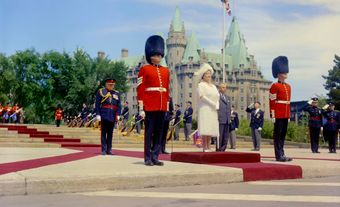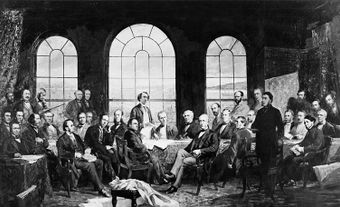King George VI (George VI, by the Grace of God of Great Britain, Ireland and the British Dominions Beyond the Seas, King, Defender of the Faith, Emperor of India) (born 14 December 1895 at York Cottage, Sandringham, Norfolk, United Kingdom; died 6 February 1952 at Sandringham House, Norfolk). The father of Queen Elizabeth II (1926 to 2022), George VI reigned during the Second World War. He was the first reigning monarch to tour Canada (in 1939) and the first monarch to hold the official title of Head of the Commonwealth (from 1949).

Early Life and Family
The future King George VI was born Prince Albert Frederick Arthur George in the reign of his great-grandmother Queen Victoria. He was named for the queen’s late husband, Prince Albert. Nicknamed “Bertie,” the young prince was the second son of the Duke and Duchess of York (later King George V and Queen Mary). His elder brother was the future King Edward VIII; he had four younger siblings.
Education and Naval Career
Although he suffered from seasickness, Albert became a naval cadet at the Royal Naval College at Osborne in 1909; he attended Britannia Royal Naval College at Dartmouth in 1911. The navy was a popular career for second sons in European royal houses during the 19th and 20th centuries. Albert served in the First World War and was mentioned in dispatches for his service as a turret officer during the 1916 Battle of Jutland. In 1918, he became the first member of the royal family to earn a pilot’s licence.
In 1919, Albert attended Trinity College Cambridge for a year, studying history, economics and civics. In 1920, he received the titles of Duke of York, Earl of Inverness and Baron Killarney. A skilled tennis player, Albert competed in the men’s doubles tournament at Wimbledon in 1926, the only member of the royal family ever to do so.
First Visit to Canada
As a naval midshipman on the HMS Cumberland, Albert had a six-month tour of duty to Canada and the Caribbean in 1913. While in Canada, he visited Niagara Falls and Toronto, umpired a cricket match in Prince Edward Island, and went salmon fishing in Quebec and Newfoundland.
Marriage and Children
On 26 April 1923, Albert married Lady Elizabeth Bowes-Lyon, daughter of the Earl and Countess of Strathmore, at Westminster Abbey in London. Albert and Elizabeth had two children, Princess Elizabeth (the future Queen Elizabeth II; 1926–2022) and Princess Margaret (1930–2002).
Public Engagements
Albert and Elizabeth went on many overseas tours in the 1920s and 1930s. During a world tour in 1927, Albert opened Parliament House in Canberra, Australia, and played doubles tennis in Jamaica with Bertrand Milbourne Clark, the first Black tennis player to compete at Wimbledon, as his partner.
Albert suffered from a stammer and had difficulty making speeches. In 1926, he began working with speech therapist Lionel Logue and his public speaking improved. Albert was considered for the role of Governor General of Canada in 1930, but his father ultimately vetoed the idea.
Accession and Coronation
On 20 January 1936, George V died, and Edward VIII became king; he abdicated on 11 December 1936 to marry American divorcée Wallis Simpson. When Albert became king, he took the name George VI to symbolize continuity with his father, George V, after the upheaval caused by the abdication crisis.

On 12 May 1937, George VI was crowned king in Westminster Abbey in London. The Coronation Oath was revised to reflect the autonomy and equality of British Dominions such as Canada, following the Balfour Report of 1926 and the 1931 Statute of Westminster. In Canada, the press described George VI as the first “King of Canada,” observing the development of a distinct Canadian Crown. The ceremony was broadcast on the radio, including coverage by the Canadian Broadcasting Corporation.

The 1939 Royal Tour
In 1939, George VI became the first reigning British and Canadian monarch to visit Canada, touring the country by train for six weeks with Queen Elizabeth. The 1939 royal tour was the most successful royal tour in Canadian history. It featured the first royal walkabout when the royal couple joined a crowd of First World War veterans after unveiling the National War Memorial in Ottawa.
At the end of the tour, the King stated, “We have had the privilege of meeting Canadians, old and young, of many proud racial origins and all walks of life. We hope we have made many friends among you.” The tour strengthened Anglo-Canadian relations just before the outbreak of the Second World War. (See 1939 Royal Tour.)

The Second World War
On 3 September 1939, the United Kingdom and France declared war on Germany. Canada declared war on Germany on 10 September. George VI addressed “all my peoples, both at home and overseas” in a radio broadcast at the outbreak of war:
In this grave hour, perhaps the most fateful in our history, for the second time in the lives of most of us we are at war. Over and over again we have tried to find a peaceful way out of the differences between ourselves and those who are now our enemies. But it has been in vain. The task will be hard. There may be dark days ahead and war is no longer confined to the battlefield.
King George VI and Queen Elizabeth toured the United Kingdom by train during the war, inspecting troops, munitions factories and neighbourhoods destroyed by German bombing raids. The king was honourary colonel-in-chief of several Canadian regiments, including Lord Strathcona’s Horse (Royal Canadians) and the Royal 22nd Regiment (the Van Doos), and reviewed Canadian troops during the Second World War. In 1940, he inspected the Royal 22nd Regiment and invited them to stand guard over Buckingham Palace and St. James’s Palace in London that April, the first non-British regiment to do so. In 1943, the King inspected Canadian troops in Sicily.

During the Blitz in 1940, when Buckingham Palace was damaged by German bombing, some thought the royal family might relocate to Canada, perhaps at Hatley Park on Vancouver Island (now Royal Roads University). Queen Elizabeth famously stated, “The princesses cannot go without me. I cannot go without the king. And the king will never leave.” The royal family remained in the United Kingdom throughout the Second World War.

Head of the Commonwealth
During King George VI’s reign, the British Empire and Dominions became a Commonwealth of equal nations. He was the last monarch to have the title Emperor of India, as India achieved independence in 1947. In 1949, George VI was declared Head of the Commonwealth, a title held by his daughter Queen Elizabeth II (until 2022), and later by his grandson King Charles III.
Death
In 1951, King George VI was diagnosed with lung cancer and had an operation to remove his left lung. Princess Elizabeth and Prince Philip, Duke of Edinburgh, represented him on a tour of Canada soon after the operation.
King George VI died in his sleep of coronary thrombosis while Elizabeth and Philip were on tour in Kenya. He was buried at St. George’s Chapel at Windsor Castle on 15 February 1952. The funeral was observed as a day of mourning throughout the Commonwealth.

 Share on Facebook
Share on Facebook Share on X
Share on X Share by Email
Share by Email Share on Google Classroom
Share on Google Classroom












